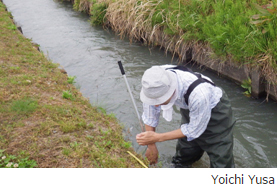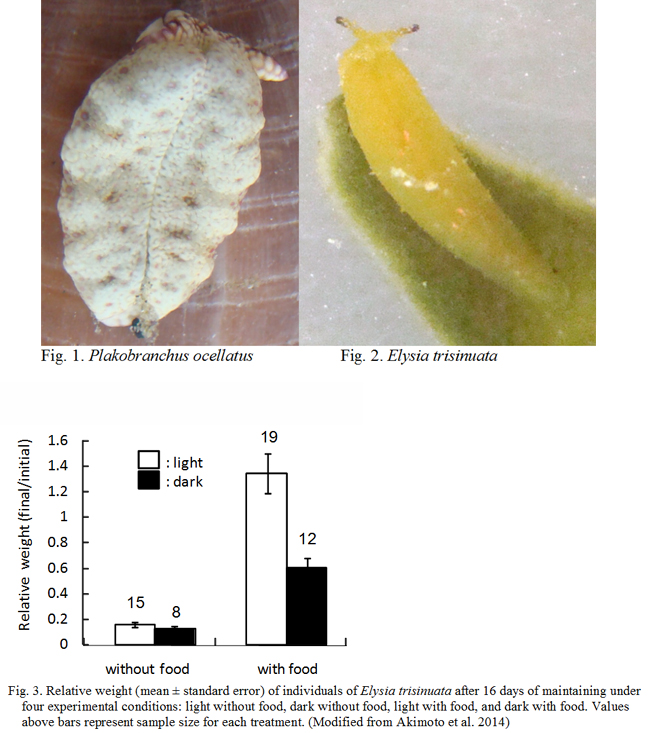"Leaves that Move?" Sea Slugs That Perform Photosynthesis
 [Release: January, 2017]
[Release: January, 2017]
Professor Yoichi Yusa
Biological Sciences Course & Environmental Sciences Course
Department of Chemistry, Biology, and Environmental Science
Faculty of Science
Nara Women's University
According to my colleague plant morphologist, we humans cannot live by photosynthesis, because we move a lot and therefore need a lot of energy, but our surface area is too small to receive enough light for photosynthesis. Is it true, then, that only plants perform photosynthesis?
Actually, many animals obtain energy through photosynthesis, such as some coral, jellyfish, giant clams, and sea squirts (these animals certainly do not move a lot, do they?). However, all of these obtain nutrients from the algae with which they have a symbiotic relationship, and they do not perform the photosynthesis themselves.
So, there are no animals that perform photosynthesis? In fact, only several members of sacoglossans, a group of sea slugs, perform photosynthesis. These slugs damage the cell surfaces of algae, ingest the contents of the cells, and keep the chloroplasts inside the body without immediately digesting them to make use of photosynthesis. Since they "steal" chloroplasts from their prey, this phenomenon is called "kleptoplasty" (stealing plastids). The interval for which the stolen chloroplasts can be maintained is usually short, just for a few days, but species such as Plakobranchus ocellatus (Fig. 1) can maintain the chloroplasts for months. Why does this unique phenomenon of kleptoplasty occur?
There are two major types of questions in biology. The first is, "how" is something possible? This is a question about a mechanism. For the case in question, this means, what types of genes and proteins make it possible for sea slugs to maintain chloroplasts within their bodies? But the other type asks "why", or what kind of advantage made this evolve. This is a question of adaptive significance. For the case in question, this means, what advantage is there for sea slugs to perform photosynthesis? Many studies have explored the mechanism of kleptoplasty. However, regarding the advantages of photosynthesis for sea slugs, although there has been some excellent classic research, simple ideas such as whether sea slugs grow better when they have light have not been investigated in a careful statistical manner.
So, my student and I began studying whether photosynthesis is advantageous for sacoglossans (Yamamoto et al., 2013, J. Mar. Biol. Ass., 93: 209-215; https://doi.org/10.1017/S0025315412000628). We collected many individuals of the species Elysia trisinuata (Fig. 2), divided them into two groups, and compared the survival and growth rates between a group that was given light and a group that was not. However, contrary to expectation, we did not find any evidence that the group given light had a better survival rate or growth rate. We were a little disappointed with this result, but upon further investigation, we found that this species can only maintain stolen chloroplasts for 2 to 4 days. Thus, next we experimented on Plakobranchus ocellatus, which maintains chloroplasts for a longer time, and for the first time we clarified the benefit of photosynthesis for sea slugs: that the survival rate and growth rate were higher if the slugs were given light, compared to if they were not.
However, do these results mean that photosynthesis really has no advantage for species like E. trisinuata that cannot maintain chloroplasts for a long time? The first sacoglossan to evolve the ability to steal chloroplasts and perform photosynthesis naturally would not have been able to maintain the chloroplasts for a long time, and it would be strange if it had no advantage at all. So, when a new student joined our laboratory, we started addressing this puzzle (Akimoto et al., 2014, Marine Biology 161: 1095-1102; http://link.springer.com/article/10.1007/s00227-014-2402-1). In the previous study, we had used individuals to which food was not given; but this time, we tried comparing the effects of light and dark, both in the case when food was given and when food was not given. We again used E. trisinuata in these experiments. For the case where food was not given, we obtained virtually the same results as before; no difference in survival or growth was observed regardless of whether light was given or not (Fig. 3, Left). However, when food was given, slug growth was improved compared to when food was not given, but most of all, there was a large difference in growth depending on whether light was given or not (Fig. 3, Right). This result showed that, in species such as E. trisinuata that cannot maintain chloroplasts for a long time, if light is provided after continuous feeding, they can obtain more energy. Probably, the first species that acquired the kleptoplasty ability must have performed photosynthesis while continuing to feed.
So, after gaining chloroplasts, is there a change in the behavior of the sea slugs toward light? Another student who joined our laboratory worked on this question (Miyamoto et al., 2015, Marine Biology, 162: 1343-1349; http://link.springer.com/article/10.1007/s00227-015-2673-1). Suppose we filled a long, narrow container with sea water, put one sea slug in the middle of it, and shone light from one end, which way would the sea slug move? The result was that, for three species of sea slugs that perform photosynthesis, almost all the individuals moved toward the light. However, for two species of sea slugs that do not perform photosynthesis, either about the same number of individuals moved toward the light or in the opposite direction, or there were more individuals who moved in the opposite direction. One researcher has called the sacoglossans "leaves that move", and they truly are leaves that are moving in search of light.
In our laboratory (Laboratory of Aquatic Ecology, Nara Women’s University), we are now working to determine the reason for the evolution of kleptoplasty, as well as other various topics in marine and freshwater ecology. There are many unsolved puzzles in biology, and solving the puzzles is fun. Would you like to work together on a big puzzle hidden in a small creature?

Recent Publications Related to this Research
1) S. Yamamoto et al.
"Effects of photosynthesis on the survival and weight retention of two kleptoplastic sacoglossan opisthobranchs"
Journal of Marine Biological Association of the United Kingdom 93: 209-215 (2013).
http://dx.doi.org/10.1017/S0025315412000628
2) A. Akimoto et al.
"Relative importance and interactive effects of photosynthesis and food in two solar-powered sea slugs"
Marine Biology 161:1095-1102 (2014).
http://link.springer.com/article/10.1007%2Fs00227-014-2402-1
3) A. Miyamoto et al.
"Phototaxis of sacoglossan sea slugs with different photosynthetic abilities: a test of the 'crawling leaves' hypothesis"
Marine Biology 162:1343-1349 (2015).
http://link.springer.com/article/10.1007%2Fs00227-015-2673-1

